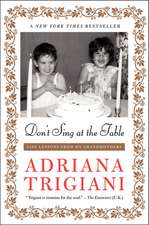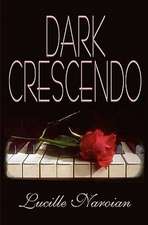Rococo
Autor Adriana Trigianien Limba Engleză Paperback – 31 mar 2006
Vezi toate premiile Carte premiată
Listen Up (2005)
Bartolomeo di Crespi is the acclaimed interior decorator of Our Lady of Fatima, New Jersey. To date, Bartolomeo has hand-selected every chandelier, sconce, and ottoman in OLOF, so when the renovation of the local church is scheduled, he assumes there is only one man for the job.
From the dazzling shores of New Jersey to the legendary fabric houses of New York City, from the prickly purveyors of fine art in London to luscious Santa Margherita on the Mediterranean coast of Italy, Bartolomeo is on a mission to bring talent, sophistication, and his aesthetic vision to his hometown.
Trigiani’s glittering mosaic of small-town characters sparkles: Bartolomeo’s hilarious sister, Toot, is in desperate need of a postdivorce transformation–thirteen years after the fact; “The Benefactor,” Aurelia Mandelbaum, the richest woman in New Jersey, has a lust for French interiors and a long-held hope that Bartolomeo will marry her myopic daughter, Capri; Father Porporino, the pastor with a secret, does his best to keep a lid on a simmering scandal; and Eydie Von Gunne, the chic international designer, steps in and changes the course of Bartolomeo’s creative life, while his confidante, cousin Christina Menecola, awaits rescue from an inconsolable grief.
Plaster of Paris, polished marble, and unbridled testosterone arrive in buckets when Bartolomeo recruits Rufus McSherry, a strapping, handsome artist, and Pedro Allercon, a stained-glass artisan, to work with him on the church’s interior. Together, the three of them will do more than blow the dust off the old Fatima frescoes–they will turn the town upside down, challenge the faithful, and restore hope where there once was none.
Brilliantly funny and as fanciful as flocked wallpaper, filled with glamorous locales from New Jersey to Europe, from Sunday Mass to the American Society of Interior Designers soirée at the Plaza Hotel, Rococo is Trigiani’s masterpiece, a classic comedy with a heart of gold leaf.
"A veritable crazy quilt of quirky Italian Americans ... Trigiani weaves all these subplots together with wonderful ease; every seam is perfectly straight, every pleat in place. Bartolomeo would expect no less. A-." -- Entertainment Weekly
"Clever ... Creating characters so lively they bounce off the page and possessing a wit so subtle that even the best jokes seem effortless, Trigiani is a master storyteller. Equal parts sass and silliness, Rococo is an artfully designed tale with enough brio to make Frank Gehry proud."-- People
From the Hardcover edition.
Preț: 106.45 lei
Nou
Puncte Express: 160
Preț estimativ în valută:
20.37€ • 21.21$ • 17.22£
20.37€ • 21.21$ • 17.22£
Carte disponibilă
Livrare economică 14-28 februarie
Preluare comenzi: 021 569.72.76
Specificații
ISBN-13: 9780812967814
ISBN-10: 081296781X
Pagini: 283
Dimensiuni: 134 x 203 x 18 mm
Greutate: 0.23 kg
Editura: BALLANTINE BOOKS
ISBN-10: 081296781X
Pagini: 283
Dimensiuni: 134 x 203 x 18 mm
Greutate: 0.23 kg
Editura: BALLANTINE BOOKS
Notă biografică
Adriana Trigiani is an award-winning playwright, television writer, and documentary filmmaker. The author of the bestselling Big Stone Gap trilogy, the New York Times bestselling novels Lucia, Lucia and The Queen of the Big Time, and co-author of the cookbook Cooking with My Sisters, Trigiani has written the screenplay for the movie Big Stone Gap, which she will also direct. She lives in New York City with her husband and daughter, and is at work on her next Big Stone Gap novel.
From the Hardcover edition.
From the Hardcover edition.
Extras
CHAPTER ONE
The Duke of Décor
on the Jersey Shore
1970
I want you to imagine my house. It’s a classic English country cottage, nestled on an inlet overlooking the Atlantic Ocean in the borough of Our Lady of Fatima, New Jersey, about five miles north of Interlaken. The fieldstone exterior gives the illusion of a small fortress, so I softened the overall effect with white hyacinth shrubs and a blanket of sky-blue morning glories cascading over the dormers like loose curls on a cherub. After all, a man’s home must first be inviting.
Every morning at sunrise a honeyed pink light fills the front room, throwing a rosy glaze on the walls that cannot be achieved with paint. Believe me, I’ve tried. I settled instead for a neutral shade on the walls, a delicate beige I call flan. When the walls are tame, the furnishings need to pop. So I found the perfect chintz, with giant jewel-toned flowers of turquoise, coral, and jade bursting on a butter-yellow background, to cover my Louis Quatorze sofa and chairs. The upholstery soaks up the light and warms the room better than a fire blazing in the hearth. Anyone who says you will tire of a bold pattern on your furniture is a fool. The right fabric will give you years of joy; it can become your signature. Scalamandré’s Triomphe #26301 has my name on it.
My day begins at dawn as I take my cup of strong black espresso outside to watch the sunrise. I learned this ritual from my mother, who worked in a bread shop. Bakers are the great philosophers of the world, mostly because they have to get up early. When the world is quiet, great art is created—or, at the very least, conceptualized. Now is the moment to sketch, make notes, and dream.
From my front porch, a dignified, simple portal with a slate floor (I laid the charcoal-gray, dusty-mauve, and smoky-blue slabs myself), I watch the colors of the sky and sea change at the whims of the wind. Sometimes the ocean crashes in foamy white waves that look like ruffles. Then, suddenly, the light is gone and everything turns to gray satin. When the sun returns, the charcoal clouds lift away and the world becomes as tranquil as a library, the water as flat as a page in a book, Venetian glass under a blue cloudless sky.
What a boon to live on the water! Such delicious shades and hues! This is a template worthy of the greatest painters. The textures of sand and stone could inspire incomparable sculptures, and the sounds—the steady lapping of the waves, the sweet chirping of the birds—make this a sanctuary. I soak up the view in all its detail and translate this glorious palette to the interiors of local homes. You see, I am the Town Decorator.
Many have compared our little borough to the village my family emigrated from, the enchanting Santa Margherita nestled in the Gulf of Genoa on the Mediterranean coast of Italy. I’ve been there, but I favor my hometown over the original. Italy, despite its earthiness and charm, can never be New Jersey. Here we value evolution and change; Italy, while it warms the heart, is a monument to the past. In America we change our rooms as often as our fashions. In Italy you’re likely to find throw pillows older than the Shroud of Turin. It’s just a different way to live.
Part of my job is to convince my clients that change is good, then guide them to the right choices. I remember when I installed a velvet headboard on my cousin Tiki Matera’s double bed (she was plagued by insomnia from the cradle) and she told me that, for the first time in her life, she felt so secure that she slept through the night. That Art Deco touch changed her room and her life—not a small thing. That’s the business I’m really in: creating appropriate surroundings to provide comfort and that essential touch of glamour. I built my company, the House of B, and my reputation on it. HOB stands for the eye of Bartolomeo di Crespi and the guts of beauty itself: truth, color, and dramatic sweep, from slipcover to oven mitt. I don’t fool around.
My work can’t be defined by one particular style. The rococo period where French design and Italian flair came together make my heart leap for joy in my chest. But, I love them all: Chinese Modern, Regency English, French Norman, Prairie Nouveau, Victorian (without the precious), Early American (with the precious), all the Louises from I through V (Vuitton, of course), postwar, prewar, bungalow, foxhole, and even the occasional log cabin. I can go big and I can do small.
I work from the inside out. Truly great interior design includes the rooms you live in and everything your eye can see from your windows. I often bring the colors from outside indoors, which soothes the soul and creates harmony. I may install a reflecting pool outside your living room to catch the moonlight, or plant a garden of wildflowers with a rose arbor anchored over a flowing fountain beyond your kitchen window, or perhaps place a wrought-iron loveseat surrounded by lilac bushes outside your bedroom for a midnight rendezvous.
Your home should inspire you to greater heights of emotion. It should crackle with color and pizzazz. Every detail is important; every tassel, tieback, and sheer should say something. Under my trained eye, stale corners become Roman baths, while bland entryways become magnificent foyers and crappy pasteboard ceilings become frescoes. Let’s face it, I can take a ranch and turn it into a villa. In fact, I did that very thing right on Vittorio Drive, three blocks away.
My life as a decorator began not with a sudden flash of inspiration, but with a problem. I was born without symmetry. This is not my real nose. As soon as I was old enough to pull myself up onto the stool in front of my mother’s dressing table (an Art Deco red enamel vanity with a pink velvet seat circa 1920), where I could pull the side mirrors in to study my face from three angles, I realized that something had to be done. From the east, my nose looked like the fin on a Cadillac, from the west, a wedge of pie, and dead on, a frightening pair of black caverns, two nostrils so wide and deep you could lose your luggage in them. It had to go.
As an Italian American, I was born into a family of prominent noses. The di Crespi clan was known for their fish (Pop had a dinghy for clamming and crabbing, and a storefront in town to sell his catch) and their profiles. We were not alone. Our neighbors were also of Italian descent, many from the same village, and they too had versions of The Beak. The variations included all possible shapes, angles, and appointments, all with the same result: too large.
I was raised to be proud of my cultural and nasal heritage, so it wasn’t shame that brought me to the surgeon, it was a desire for perfection. My instinct is to create balance. Faces, like buildings, require good bones.
As soon as I could save up enough money (I worked after school and for five summers in the Mandelbaums’ bank as a coin sorter and roller), I took the bus from Our Lady of Fatima (OLOF) to the office of Dr. Jonas Berman on East Eighty-sixth Street in Manhattan. I was eighteen years old with a spiral-bound sketch pad under my arm and a checkbook in my pocket.
First, I’d drawn a self-portrait in charcoal, showing my original nose. Then, in a series of detailed drawings, I fashioned the nose I wanted from every angle. Dr. Berman flipped through the pad. Amazed at my artistic skill, he cited Leonardo da Vinci’s pencil sketches of early flying machines as being substandard to my talent.
If I was going to have rhinoplasty, I wanted to make sure I had the nose of my dreams. I didn’t want a hatchet job that would leave me with a Hollywood pug. I wanted regal, straight, and classic. In short, Italianate without the size. I got exactly what I wanted.
My sister, Toot (as in the song “Toot, Toot, Tootsie,” not the toot of a horn), who is eleven years older than me, was the first person to see my new nose when the swelling went down. She was so thrilled at the result that she convinced my father to sell his car so she could have the same surgery. My father, never one to tell a woman no, paid for her to have The Operation (as my mother came to call it). Never mind that I had worked like a farmer to earn my new profile. But I don’t hold a grudge.
Toot elected to have her nose done not in New York City by my capable surgeon, but by a doctor in Jersey City who was rumored to have given Vic Damone his signature tilt. (I am the only person in my family who does not believe in medical bargains.) When Dr. Mavrodontis peeled Toot’s bandages off, Mom, Pop, and I were there for the unveiling. Mama clapped her hands joyfully as Papa got a tear in his eye. Talk about change. Her new nose had a sharp tip with an upturn so steep you could hang a Christmas stocking off it. Gone was her old nose, which had looked like an elbow; but was this delicate Ann Miller version an improvement?
To be fair, the new nose gave my sister the dose of self-confidence she needed. She suddenly believed she was beautiful, so she went on a spartan diet of well-done steak and raw tomatoes and lost a good thirty pounds, tweezed her eyebrows and straightened her hair (by sleeping on wet orange-juice cans every night for a year), and, shortly thereafter, in the right pair of black clam diggers and a tight angora sweater, fell in love with Alonzo “Lonnie” Falcone, a jeweler, at a Knights of Columbus weenie roast in Belmar. Six months later they had a big church wedding at Our Lady of Fatima Church and three sons followed in short order. Her nose may not be perfect, but it was lucky.
817 Corinne Way has been Toot’s address for eighteen years. After they lived for a couple of hardscrabble years in a row house in Bayonne, Lonnie’s business took off, so they bought a home in OLOF to be near my folks. When Toot and Lonnie divorced, she got the house, a lovely Georgian with grand Palladian columns anchoring a polished oak door trimmed in squares of leaded glass.
I pull up in the driveway next to my sister’s chartreuse Cadillac. I get out of the car, taking a small footstool that I reupholstered for Toot with me. The lawn is freshly mowed and green. The boxwood hedges are trimmed and tidy. Everything about the exterior of the house is appropriate except for one glaring design misfire: My sister mucked up the entrance with a countrified porch swing she found at a tag sale in Maine. I tell her that a Georgian with a porch swing is like a hooker in a girdle, but she keeps the swing and I keep my mouth shut. The truth is, I’m a little afraid of her. Toot has always been a second mother to me, and any Italian son will tell you that two Italian mothers in a lifetime is a handful. I’m not complaining, because we adore each other; I defer to her on family matters, and she to me on aesthetic ones (most of the time; after all, she kept the swing).
“I’m here!” I holler cheerfully. Toot’s house always smells of anisette and fresh-perked coffee, the lovely bouquet of our mother’s home.
“Back here, B,” she yells.
Carrying the footstool I’d re-covered in pale blue wool for her boudoir, I make my way down the long hallway, which is papered in a Schumacher pale-yellow-and-white paisley print. I decorated the entire house, but my favorite room is her kitchen. I did a real number on it.
First, I sent my sister to Las Vegas to visit Cousin Iggy With The Asthma for three months. Then I gutted the old kitchen. I installed a bay window on the back wall to maximize the light and designed a Roman shade of pure white muslin to let in the sun but keep out the nosy neighbors. Underneath I built a window seat with cushions covered in a practical red cotton twill (Duralee Hot Red #429). I believe that any fabrics used in a kitchen should be washable.
For fun, I used oversized zippers on the seat cushions to pick up the metal accents of the appliances. To bring nature indoors, I used rustic white birch paneling on the wall around the window. I papered the remaining walls with a bold Colefax and Fowler red-and-white stripe and installed white Formica cabinets with red ceramic pulls. The result is peppermint-candy delish!
The countertop, in white marble, has an extension that swings out in an L shape to make a breakfast nook, with sleek bar stools covered in white patent leather with brass-stud trim. The studs are an excellent accent to the shimmering copper pots that hang over the sink area like charms on a bracelet. The refrigerator (side-by-side) and stove (gas) were purchased in white, but I had them delivered to Chubby’s Garage, where they were jet-spray-painted a bright, shiny, fiery red. I’m forever thinking of ways to give design that extra kick, using unlikely sources. Take note.
The kitchen table is topped with wide white ceramic tiles. Beneath the table, I installed a cutting board that pulls out for additional workspace. It comes in handy when Toot makes pasta. The table is surrounded by cozy booth seating in a cheerful red gingham. The palette works. It’s vibrant! It’s up! When you stand in this kitchen, you feel as though you are on the inside of a tomato, the exact effect I wanted.
“You like my pants set? It’s new.” Toot does her version of a model’s twirl, pointing her right foot out in front of the left and holding her arms out waist-high like a milkmaid. The sweater is a disaster, an enormous white pilgrim collar on a cable-knit orange cardigan. (I can see that the wool is a fine cashmere, but what good is it? The eye sees round, round, round instead of sleek. My sister needs length, not width.) The brown slacks have a wide bell hem. She looks like a piece of candy corn. “It’s a St. John knit,” she says, giving me an in-the-know wink.
“Only a saint could get away with such a color combination,” I say.
Like all Mediterranean girls, my sister is aging well. By soft candlelight or with the help of a dimmer switch, she has the look of a plump Natalie Wood. In broad daylight, she’s a dead ringer for our great-grandmother, the pleasantly pudgy Bartolomea Farfanfiglia, whom we never knew, but who stares at us with disgust from a sepia photograph on the television set.
From the Hardcover edition.
The Duke of Décor
on the Jersey Shore
1970
I want you to imagine my house. It’s a classic English country cottage, nestled on an inlet overlooking the Atlantic Ocean in the borough of Our Lady of Fatima, New Jersey, about five miles north of Interlaken. The fieldstone exterior gives the illusion of a small fortress, so I softened the overall effect with white hyacinth shrubs and a blanket of sky-blue morning glories cascading over the dormers like loose curls on a cherub. After all, a man’s home must first be inviting.
Every morning at sunrise a honeyed pink light fills the front room, throwing a rosy glaze on the walls that cannot be achieved with paint. Believe me, I’ve tried. I settled instead for a neutral shade on the walls, a delicate beige I call flan. When the walls are tame, the furnishings need to pop. So I found the perfect chintz, with giant jewel-toned flowers of turquoise, coral, and jade bursting on a butter-yellow background, to cover my Louis Quatorze sofa and chairs. The upholstery soaks up the light and warms the room better than a fire blazing in the hearth. Anyone who says you will tire of a bold pattern on your furniture is a fool. The right fabric will give you years of joy; it can become your signature. Scalamandré’s Triomphe #26301 has my name on it.
My day begins at dawn as I take my cup of strong black espresso outside to watch the sunrise. I learned this ritual from my mother, who worked in a bread shop. Bakers are the great philosophers of the world, mostly because they have to get up early. When the world is quiet, great art is created—or, at the very least, conceptualized. Now is the moment to sketch, make notes, and dream.
From my front porch, a dignified, simple portal with a slate floor (I laid the charcoal-gray, dusty-mauve, and smoky-blue slabs myself), I watch the colors of the sky and sea change at the whims of the wind. Sometimes the ocean crashes in foamy white waves that look like ruffles. Then, suddenly, the light is gone and everything turns to gray satin. When the sun returns, the charcoal clouds lift away and the world becomes as tranquil as a library, the water as flat as a page in a book, Venetian glass under a blue cloudless sky.
What a boon to live on the water! Such delicious shades and hues! This is a template worthy of the greatest painters. The textures of sand and stone could inspire incomparable sculptures, and the sounds—the steady lapping of the waves, the sweet chirping of the birds—make this a sanctuary. I soak up the view in all its detail and translate this glorious palette to the interiors of local homes. You see, I am the Town Decorator.
Many have compared our little borough to the village my family emigrated from, the enchanting Santa Margherita nestled in the Gulf of Genoa on the Mediterranean coast of Italy. I’ve been there, but I favor my hometown over the original. Italy, despite its earthiness and charm, can never be New Jersey. Here we value evolution and change; Italy, while it warms the heart, is a monument to the past. In America we change our rooms as often as our fashions. In Italy you’re likely to find throw pillows older than the Shroud of Turin. It’s just a different way to live.
Part of my job is to convince my clients that change is good, then guide them to the right choices. I remember when I installed a velvet headboard on my cousin Tiki Matera’s double bed (she was plagued by insomnia from the cradle) and she told me that, for the first time in her life, she felt so secure that she slept through the night. That Art Deco touch changed her room and her life—not a small thing. That’s the business I’m really in: creating appropriate surroundings to provide comfort and that essential touch of glamour. I built my company, the House of B, and my reputation on it. HOB stands for the eye of Bartolomeo di Crespi and the guts of beauty itself: truth, color, and dramatic sweep, from slipcover to oven mitt. I don’t fool around.
My work can’t be defined by one particular style. The rococo period where French design and Italian flair came together make my heart leap for joy in my chest. But, I love them all: Chinese Modern, Regency English, French Norman, Prairie Nouveau, Victorian (without the precious), Early American (with the precious), all the Louises from I through V (Vuitton, of course), postwar, prewar, bungalow, foxhole, and even the occasional log cabin. I can go big and I can do small.
I work from the inside out. Truly great interior design includes the rooms you live in and everything your eye can see from your windows. I often bring the colors from outside indoors, which soothes the soul and creates harmony. I may install a reflecting pool outside your living room to catch the moonlight, or plant a garden of wildflowers with a rose arbor anchored over a flowing fountain beyond your kitchen window, or perhaps place a wrought-iron loveseat surrounded by lilac bushes outside your bedroom for a midnight rendezvous.
Your home should inspire you to greater heights of emotion. It should crackle with color and pizzazz. Every detail is important; every tassel, tieback, and sheer should say something. Under my trained eye, stale corners become Roman baths, while bland entryways become magnificent foyers and crappy pasteboard ceilings become frescoes. Let’s face it, I can take a ranch and turn it into a villa. In fact, I did that very thing right on Vittorio Drive, three blocks away.
My life as a decorator began not with a sudden flash of inspiration, but with a problem. I was born without symmetry. This is not my real nose. As soon as I was old enough to pull myself up onto the stool in front of my mother’s dressing table (an Art Deco red enamel vanity with a pink velvet seat circa 1920), where I could pull the side mirrors in to study my face from three angles, I realized that something had to be done. From the east, my nose looked like the fin on a Cadillac, from the west, a wedge of pie, and dead on, a frightening pair of black caverns, two nostrils so wide and deep you could lose your luggage in them. It had to go.
As an Italian American, I was born into a family of prominent noses. The di Crespi clan was known for their fish (Pop had a dinghy for clamming and crabbing, and a storefront in town to sell his catch) and their profiles. We were not alone. Our neighbors were also of Italian descent, many from the same village, and they too had versions of The Beak. The variations included all possible shapes, angles, and appointments, all with the same result: too large.
I was raised to be proud of my cultural and nasal heritage, so it wasn’t shame that brought me to the surgeon, it was a desire for perfection. My instinct is to create balance. Faces, like buildings, require good bones.
As soon as I could save up enough money (I worked after school and for five summers in the Mandelbaums’ bank as a coin sorter and roller), I took the bus from Our Lady of Fatima (OLOF) to the office of Dr. Jonas Berman on East Eighty-sixth Street in Manhattan. I was eighteen years old with a spiral-bound sketch pad under my arm and a checkbook in my pocket.
First, I’d drawn a self-portrait in charcoal, showing my original nose. Then, in a series of detailed drawings, I fashioned the nose I wanted from every angle. Dr. Berman flipped through the pad. Amazed at my artistic skill, he cited Leonardo da Vinci’s pencil sketches of early flying machines as being substandard to my talent.
If I was going to have rhinoplasty, I wanted to make sure I had the nose of my dreams. I didn’t want a hatchet job that would leave me with a Hollywood pug. I wanted regal, straight, and classic. In short, Italianate without the size. I got exactly what I wanted.
My sister, Toot (as in the song “Toot, Toot, Tootsie,” not the toot of a horn), who is eleven years older than me, was the first person to see my new nose when the swelling went down. She was so thrilled at the result that she convinced my father to sell his car so she could have the same surgery. My father, never one to tell a woman no, paid for her to have The Operation (as my mother came to call it). Never mind that I had worked like a farmer to earn my new profile. But I don’t hold a grudge.
Toot elected to have her nose done not in New York City by my capable surgeon, but by a doctor in Jersey City who was rumored to have given Vic Damone his signature tilt. (I am the only person in my family who does not believe in medical bargains.) When Dr. Mavrodontis peeled Toot’s bandages off, Mom, Pop, and I were there for the unveiling. Mama clapped her hands joyfully as Papa got a tear in his eye. Talk about change. Her new nose had a sharp tip with an upturn so steep you could hang a Christmas stocking off it. Gone was her old nose, which had looked like an elbow; but was this delicate Ann Miller version an improvement?
To be fair, the new nose gave my sister the dose of self-confidence she needed. She suddenly believed she was beautiful, so she went on a spartan diet of well-done steak and raw tomatoes and lost a good thirty pounds, tweezed her eyebrows and straightened her hair (by sleeping on wet orange-juice cans every night for a year), and, shortly thereafter, in the right pair of black clam diggers and a tight angora sweater, fell in love with Alonzo “Lonnie” Falcone, a jeweler, at a Knights of Columbus weenie roast in Belmar. Six months later they had a big church wedding at Our Lady of Fatima Church and three sons followed in short order. Her nose may not be perfect, but it was lucky.
817 Corinne Way has been Toot’s address for eighteen years. After they lived for a couple of hardscrabble years in a row house in Bayonne, Lonnie’s business took off, so they bought a home in OLOF to be near my folks. When Toot and Lonnie divorced, she got the house, a lovely Georgian with grand Palladian columns anchoring a polished oak door trimmed in squares of leaded glass.
I pull up in the driveway next to my sister’s chartreuse Cadillac. I get out of the car, taking a small footstool that I reupholstered for Toot with me. The lawn is freshly mowed and green. The boxwood hedges are trimmed and tidy. Everything about the exterior of the house is appropriate except for one glaring design misfire: My sister mucked up the entrance with a countrified porch swing she found at a tag sale in Maine. I tell her that a Georgian with a porch swing is like a hooker in a girdle, but she keeps the swing and I keep my mouth shut. The truth is, I’m a little afraid of her. Toot has always been a second mother to me, and any Italian son will tell you that two Italian mothers in a lifetime is a handful. I’m not complaining, because we adore each other; I defer to her on family matters, and she to me on aesthetic ones (most of the time; after all, she kept the swing).
“I’m here!” I holler cheerfully. Toot’s house always smells of anisette and fresh-perked coffee, the lovely bouquet of our mother’s home.
“Back here, B,” she yells.
Carrying the footstool I’d re-covered in pale blue wool for her boudoir, I make my way down the long hallway, which is papered in a Schumacher pale-yellow-and-white paisley print. I decorated the entire house, but my favorite room is her kitchen. I did a real number on it.
First, I sent my sister to Las Vegas to visit Cousin Iggy With The Asthma for three months. Then I gutted the old kitchen. I installed a bay window on the back wall to maximize the light and designed a Roman shade of pure white muslin to let in the sun but keep out the nosy neighbors. Underneath I built a window seat with cushions covered in a practical red cotton twill (Duralee Hot Red #429). I believe that any fabrics used in a kitchen should be washable.
For fun, I used oversized zippers on the seat cushions to pick up the metal accents of the appliances. To bring nature indoors, I used rustic white birch paneling on the wall around the window. I papered the remaining walls with a bold Colefax and Fowler red-and-white stripe and installed white Formica cabinets with red ceramic pulls. The result is peppermint-candy delish!
The countertop, in white marble, has an extension that swings out in an L shape to make a breakfast nook, with sleek bar stools covered in white patent leather with brass-stud trim. The studs are an excellent accent to the shimmering copper pots that hang over the sink area like charms on a bracelet. The refrigerator (side-by-side) and stove (gas) were purchased in white, but I had them delivered to Chubby’s Garage, where they were jet-spray-painted a bright, shiny, fiery red. I’m forever thinking of ways to give design that extra kick, using unlikely sources. Take note.
The kitchen table is topped with wide white ceramic tiles. Beneath the table, I installed a cutting board that pulls out for additional workspace. It comes in handy when Toot makes pasta. The table is surrounded by cozy booth seating in a cheerful red gingham. The palette works. It’s vibrant! It’s up! When you stand in this kitchen, you feel as though you are on the inside of a tomato, the exact effect I wanted.
“You like my pants set? It’s new.” Toot does her version of a model’s twirl, pointing her right foot out in front of the left and holding her arms out waist-high like a milkmaid. The sweater is a disaster, an enormous white pilgrim collar on a cable-knit orange cardigan. (I can see that the wool is a fine cashmere, but what good is it? The eye sees round, round, round instead of sleek. My sister needs length, not width.) The brown slacks have a wide bell hem. She looks like a piece of candy corn. “It’s a St. John knit,” she says, giving me an in-the-know wink.
“Only a saint could get away with such a color combination,” I say.
Like all Mediterranean girls, my sister is aging well. By soft candlelight or with the help of a dimmer switch, she has the look of a plump Natalie Wood. In broad daylight, she’s a dead ringer for our great-grandmother, the pleasantly pudgy Bartolomea Farfanfiglia, whom we never knew, but who stares at us with disgust from a sepia photograph on the television set.
From the Hardcover edition.
Recenzii
Praise for Adriana Trigiani
The Queen of the Big Time
“Full-bodied and elegantly written . . . [Trigiani builds The Queen of the Big Time] around an old-fashioned love story. . . . Pure pleasure.”
–The Washington Post Book World
“Moving and poignant . . . Trigiani has again defied categorization. She is more than a one-hit wonder, more than a Southern writer, more than a women’s novelist. She is an amazing young talent.”
–Richmond Times-Dispatch
Lucia, Lucia
“This heartwarming tale is full of lessons about taking risks in life and love.”
–Cosmopolitan
“Trigiani’s writing is as dazzling as Lucia’s dresses.”
–USA Today
“Seamlessly superb storytelling . . . Trigiani never loses hold of the hearts of her characters–or of the wisdom that tragedy and redemption are also part of life.”
–St. Louis Post-Dispatch
From the Hardcover edition.
The Queen of the Big Time
“Full-bodied and elegantly written . . . [Trigiani builds The Queen of the Big Time] around an old-fashioned love story. . . . Pure pleasure.”
–The Washington Post Book World
“Moving and poignant . . . Trigiani has again defied categorization. She is more than a one-hit wonder, more than a Southern writer, more than a women’s novelist. She is an amazing young talent.”
–Richmond Times-Dispatch
Lucia, Lucia
“This heartwarming tale is full of lessons about taking risks in life and love.”
–Cosmopolitan
“Trigiani’s writing is as dazzling as Lucia’s dresses.”
–USA Today
“Seamlessly superb storytelling . . . Trigiani never loses hold of the hearts of her characters–or of the wisdom that tragedy and redemption are also part of life.”
–St. Louis Post-Dispatch
From the Hardcover edition.
Descriere
This is the story of one man and his artistic vision in a place in desperate need of an aesthetic absolute, or, at the very least, a good deal on flocked wallpaper. A strapping, handsome painter energizes the women in the town, galvanizes the faithful, and restores hope where there was none.
Premii
- Listen Up Editor's Choice, 2005













